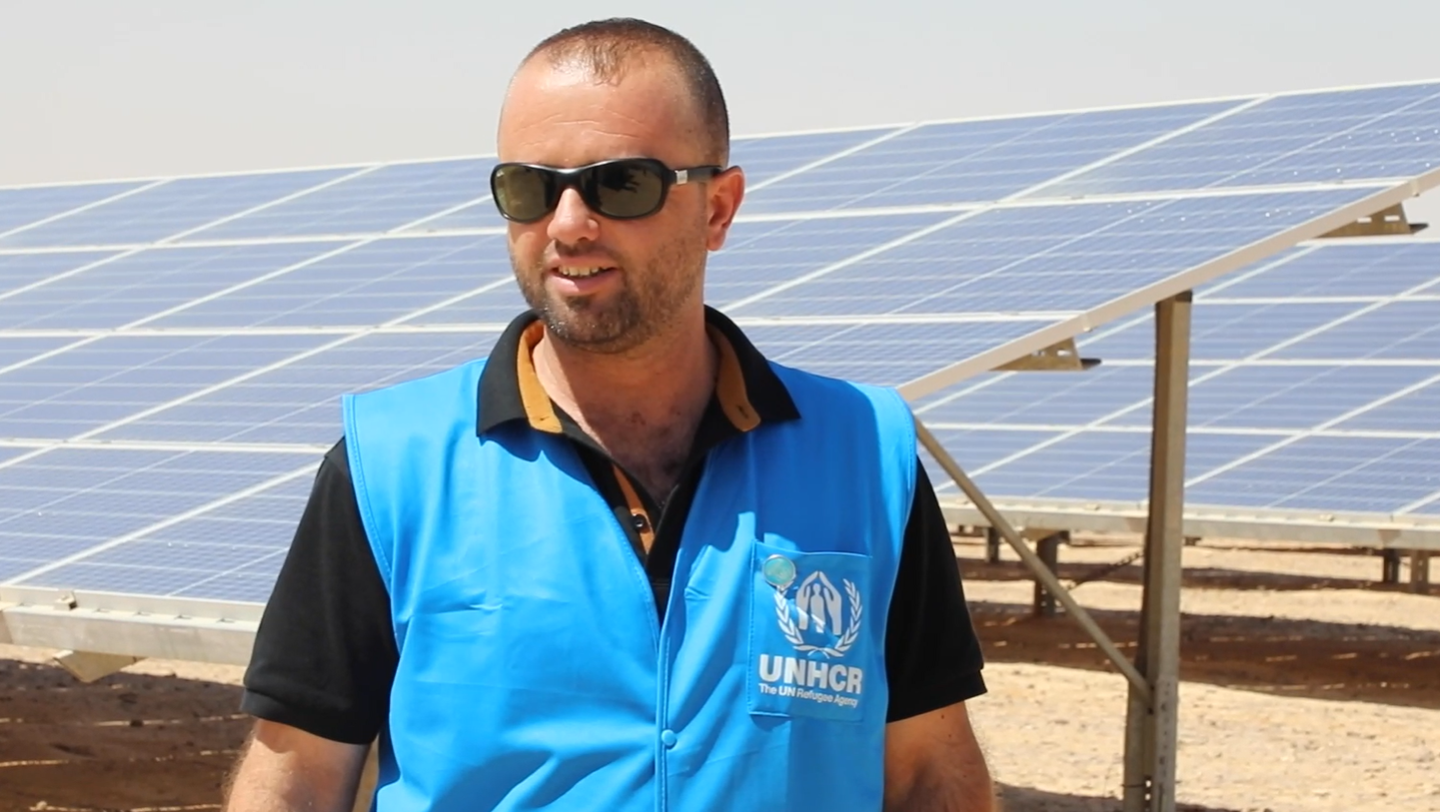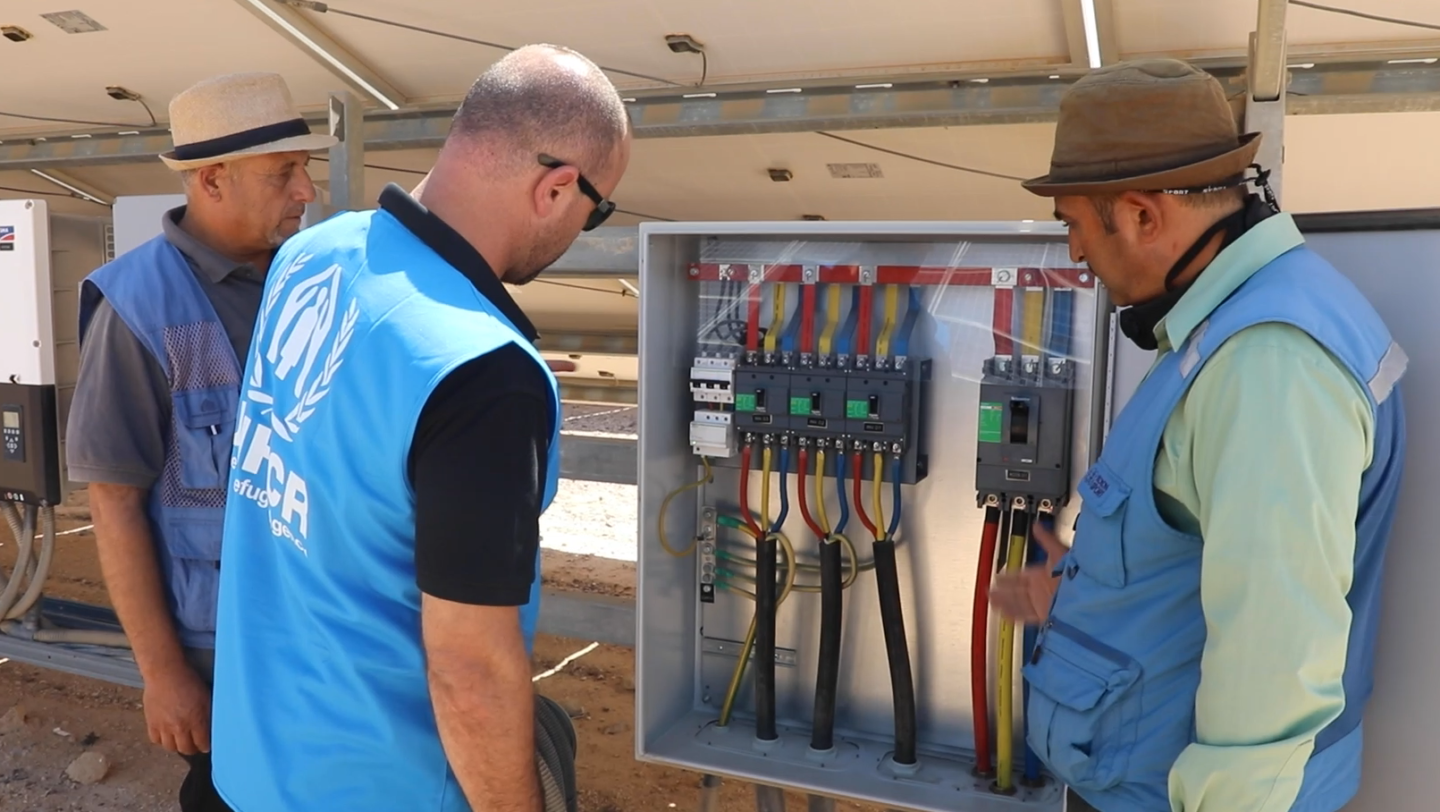Refugees helping refugees
Syrian refugee electrical engineers are supporting UNHCR to run the solar plant in Azraq Camp
In 2017, the solar farm in Azraq refugee camp in Jordan was the first solar plant built in a refugee setting in the world.
In 2017, Azraq refugee camp was the first refugee camp in the world to open a solar power plant, providing power and electricity to the camp’s 40,000 inhabitants. Five years later, the solar plant is now almost exclusively run by refugees under the supervision of UNHCR, the UN Refugee Agency.
Hatem is one of seven refugees working on the power plant. Until recently all members of the team had been employed under incentive-based volunteer (IBV) contracts which provide a small stipend to refugees working in the camp. There are currently 1,800 refugees employed under such contracts in Azraq, supporting with everything from ensuring the camp’s streets are clean to being teaching assistants within the schools.

Hatem, a Syrian refugee, has been employed by UNHCR to work at the solar plant in Azraq Camp.
Despite this, IBV positions within the camp are limited and competition is fierce as many more refugees hope to be employed and receive an income for their families. As a result, contracts are limited to a maximum of six months a year per person, before being rotated to give another refugee an opportunity. In recognition of the skills and expertise needed for refugees working on the solar plant, however, an alternative employment modality had to be found.
For Hatem, an electrical engineer with over 20 years of experience of working in the field both back in Syria and now as a refugee in Jordan, a United Nations Volunteer (UNV) contact, effectively rendering him an employee with UNHCR, provided the perfect solution.
“When there was an opportunity to be employed by UNHCR, I felt that my dreams could be realized,” explains Hatem.
Since July 2021, Hatem has therefore joined UNHCR’s technical team in Azraq Camp. Working Sunday to Thursday, his responsibilities include ensuring that the solar plant is functioning smoothly as well as checking on the general electrical grid and network that exists in the camp.
After its opening in 2017, the solar plant has subsequently undergone three expansions and now produces 8,000 mWh of energy every year and is connected directly to 9,000 shelters in the camp, delivering 14 hours of electricity per day directly into refugees’ homes. Over the course of the last five years, ten refugee engineers have been specifically trained to support its day-to-day operations. For Hatem, this experience has been invaluable.

Hatem and two other refugee volunteers working on the solar plant in Azraq Camp inspect the cables connecting the inverters to the electrical grid.
“In Syria, I studied electrical engineering but just worked as a general electrician before we were forced to flee. There were no solar plants back where we lived in Syria. The first time I started to work on one was here. I have learned so much from this, and from all the experts who have come to support from outside the camp.”
The employment of Hatem with UNHCR represents a growing shift in UNHCR’s approach in Jordan to utilize the skills of refugees within our programming. In addition to Hatem, UNHCR has also recruited nine refugee doctors in 2021, through UNV contracts, to support the COVID-19 response.
“We know the community, the challenges, the needs. Who is better to support us than us,” reflects Hatem.
Moving forward into 2022 and beyond, as refugee situations increasingly become more protracted, plans to build upon experiences such as Hatem’s are increasing.
“We have an opportunity here to transform the refugee operation if we tap into the existing skills within the community more effectively, and empower refugees to assume a stronger role in providing services in the camp,” concludes UNHCR Jordan Representative, Dominik Bartsch.
Share on Facebook Share on Twitter
